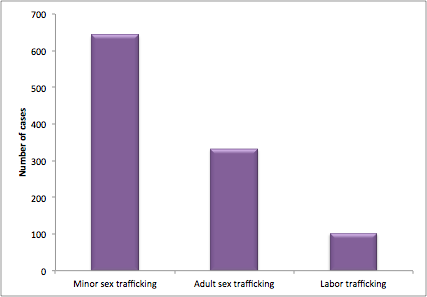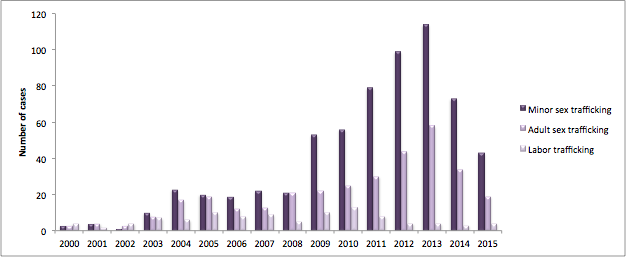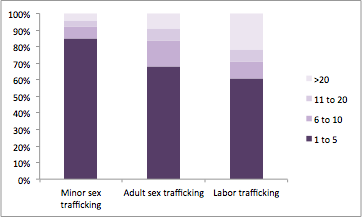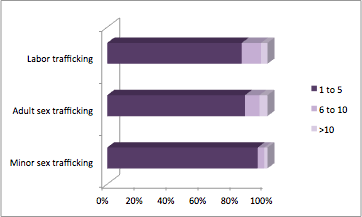TYPES OF TRAFFICKING
Between 2000-2015, there have been 642 federally prosecuted minor sex trafficking cases compared to 332 adult sex trafficking cases and 102 labor trafficking cases. The sharp increase in minor sex trafficking prosecutions began in 2009 with a 443% increase in a five-year period between 2008 and 2013. However, prosecutions data reveal that, on average, there are fewer victims recovered and less defendants prosecuted in minor sex trafficking cases than adult sex trafficking and labor trafficking cases.
NUMBER OF CASES BY TYPE OF TRAFFICKING
Minor sex trafficking cases dominate federal prosecution strategy on human trafficking

Overall, there has been more than double the number of federally prosecuted minor sex trafficking cases than adult sex trafficking and labor trafficking cases combined. Between 2000-2015, 642 minor sex trafficking cases were prosecuted federally compared to 332 adult sex trafficking cases and 102 labor trafficking cases.
This does not necessarily mean that the prevalence of minor sex trafficking is higher than that of adult sex trafficking and labor trafficking, but instead may be reflective of certain biases towards prosecuting minor sex trafficking cases in the United States. There are several potential reasons for this prosecutorial bias.
First, is that force, fraud, and coercion need not be present to classify a minor sex trafficking case as a severe form of sex trafficking; therefore, evidentiary standards to prove criminality in minor sex trafficking cases are lower. This makes the likelihood of a successful prosecution higher. Additionally, a minor sex trafficking conviction carries a mandatory minimum sentence of 15 years if the victim is under the age of 14 and 10 years if the victim is between 15-18 years old.
Second, public opinion research on human trafficking in the United States reveals that the public is significantly more concerned about minor sex trafficking than any other form of human trafficking (Bouché, Farrell, Wittmer 2015). Thus, prosecution of a minor sex trafficking case is likely to resonate the most with the public.
Finally, higher numbers of prosecutions for minor sex trafficking cases indicate that there may also be some level of bias in the direction of investigating minor sex trafficking among law enforcement, perhaps in response to public pressure.
NUMBER OF CASES PER YEAR BY TYPE OF TRAFFICKING
Over 400% increase in minor sex trafficking cases in five-year period between 2008-2013.

Starting in 2009, the number of minor sex trafficking prosecutions began to climb significantly. In 2008, there were 21 minor sex trafficking prosecutions, and this increased to 114 in 2013, a 443% increase over a five-year period.
There was also a significant increase in adult sex trafficking prosecutions between 2008 and 2013. In 2008, there were 21 cases prosecuted, and this increased to 58 cases in 2013, a 176% increase. However, prosecutions for both minor and adult sex trafficking dropped in 2014 and 2015.
There are several potential reasons for the sharp increase beginning in 2009. First, the Trafficking Victims Protection Act was reauthorized in 2008 for the fourth time. This reauthorization may have served as a signal to prosecuting agencies that there is strong public and political will to prioritize these cases. Additionally, in 2009 Craigslist signed a joint statement indicating that it would take steps to decrease the number of underage sex ads on the site, and in 2010 was subpoenaed to determine whether it was actually taking these steps. Similarly, in 2011, Backpage was scrutinized for facilitating sex trafficking through its adult services section, faced several lawsuits, and lost all credit card processing agreements in 2015. The increased scrutiny of Craigslist and Backpage may have catalyzed the increase in prosecutions of these cases. Finally, it was not until 2007 that half of the states in the U.S. passed stand-alone laws criminalizing human trafficking, which reflects a time period when momentum across the country was building.
On the other hand, federal prosecutions of labor trafficking cases have remained relatively constant across the entire time period from 2000 to 2015. This may be reflective of the fact that the conversation around human trafficking in the United States has revolved largely around sex trafficking, with very little attention to labor trafficking. There are several potential reasons for the lack of attention to labor trafficking.
First, research from federal prosecutions data reveals that 93% of labor trafficking victims in the United States are foreign nationals (Bouché 2017, 19). This is in contrast to the victims in minor sex trafficking prosecutions, where 92% of the victims are American. It is possible that cases of human trafficking involving foreign national victims are prioritized less than those cases involving American victims (and especially American minor victims).
Second, labor trafficking cases often involve large corporate interests that intersect with a variety of industries and sectors. For example, cleaning services for hotels, large retailers, and fast food chains are often provided through labor contracting firms that may be engaging in unscrupulous labor practices, making the larger corporations potentially complicit. The agriculture and construction industries in the U.S. have also relied on migrant laborers who often do not know their rights and are therefore taken advantage of. Yet Americans rely on lower prices for goods and services. Thus, there are a number of complicating interests and factors that may make labor trafficking prosecutions less of a political priority, and potentially a political loss.
NUMBER OF VICTIMS PER CASE BY TYPE OF TRAFFICKING
On average, more victims are recovered in labor trafficking than minor sex trafficking cases.

Federal prosecutions data from 2000 to 2015 reveal that 22% of labor trafficking cases involved more than 20 victims, compared to 9% of adult sex trafficking cases and 4% of minor sex trafficking cases. In other words, on average, more victims are recovered prosecuting labor trafficking cases than sex trafficking cases.
This is despite the current prosecution strategy in which there are significantly more minor and adult sex trafficking cases prosecuted than labor trafficking cases. This may indicate that the current prosecution strategy is yielding less of an impact in terms of numbers of victims rescued than it could if there were more labor trafficking prosecutions.
Some examples of large labor trafficking cases include U.S. v. Baravik, et al. (2009), which involved 800 victims from numerous countries working in various industries, U.S. v. Ramos, et al. (2001), involving 50 victims of forced labor in the agriculture sector, or U.S. v. Cenesus, et al. (2010), with over 100 agricultural trafficking victims. A search of the database for number of victims by type of trafficking will provide a more comprehensive list of these cases.
NUMBER OF DEFENDANTS PER CASE BY TYPE OF TRAFFICKING
Majority of human trafficking prosecutions involve less than five codefendants per case.

Across all three types of human trafficking, the number of defendants prosecuted per case is low. Ninety-four percent of minor sex trafficking cases, 86% of adult sex trafficking cases, and 84% of labor trafficking cases involve one to five defendants or co-defendants prosecuted in the case.
Bouché (2017, 18) finds that “the increase in prosecutions [of human trafficking cases between 2000-2015] is primarily due to prosecutions of cases with less than three defendants. Indeed, only 194 of the 862 cases (22%) indicted three or more codefendants in the same case.” On the other hand, there has been an increasing amount of research examining the extent to which human trafficking operations are “organized” and networked. This potentially indicates that there may be a discrepancy between the strategy of prosecuting smaller cases with less defendants and the reality of the complex criminal networks involved in human trafficking.